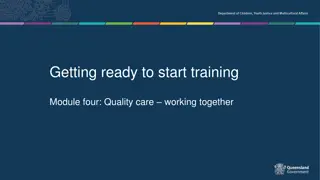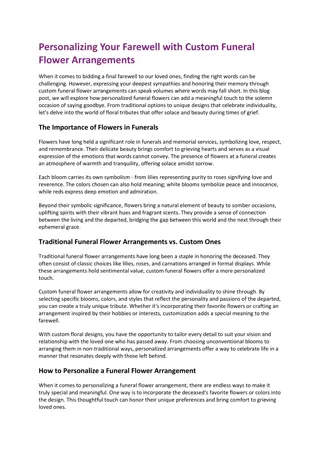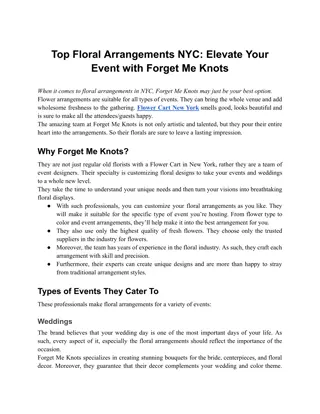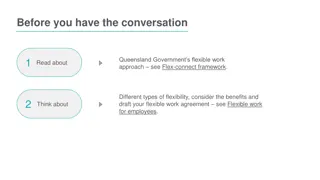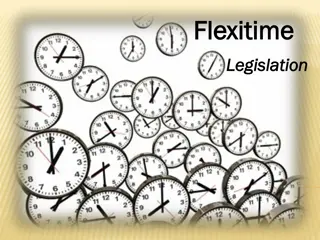Flexible Working Arrangements
This presentation focuses on flexible working, outlining the laws and best practices associated with it. It covers the process of receiving and handling requests for flexibility, as well as the possible outcomes. Examples of flexible working arrangements are provided, along with details on employee rights and managerial responsibilities. The presentation emphasizes the importance of handling such requests in a reasonable manner and highlights the role of internal policies in guiding the process.
Download Presentation

Please find below an Image/Link to download the presentation.
The content on the website is provided AS IS for your information and personal use only. It may not be sold, licensed, or shared on other websites without obtaining consent from the author.If you encounter any issues during the download, it is possible that the publisher has removed the file from their server.
You are allowed to download the files provided on this website for personal or commercial use, subject to the condition that they are used lawfully. All files are the property of their respective owners.
The content on the website is provided AS IS for your information and personal use only. It may not be sold, licensed, or shared on other websites without obtaining consent from the author.
E N D
Presentation Transcript
Flexible working Training presentation
Flexible working [Insert date] [Insert speaker name, insert speaker job title]
Training objectives This presentation is designed to: set out the law and best practice on flexible working identify the considerations upon receiving a request provide guidance on the possible outcomes of the process.
What is flexible working? A change in current contractual working patterns or locations. Designed to allow employees to strike a better balance between work and their personal commitments outside of work. Certain employees have a statutory right to make a request for flexibility. Requests are limited to one in every 12-month period preventing repetitive or excessive requests.
What is flexible working? Examples: reducing working days from 5 to 3 days later starts and later finishes early finishes compressed hours eg doing 5 days work in 4 days working Tuesday-Saturday as opposed to Monday-Friday job sharing with a colleague term time working only working from home instead of at the normal workplace
What is flexible working? The law creates a right to request flexibility. There is no right to receive flexibility although managers cannot refuse a request unless a specified business reason applies. Managers are under a duty to handle flexible working requests in a reasonable manner
What is flexible working? Acas Code of Practice on Handling in a reasonable manner requests to work flexibly : sets out minimum procedure designed to help employers meet their legal duty encourages managers to: discuss the request consider the request deal with any requests promptly.
What is flexible working? Internal policy will set out the organisation s flexible working procedure. Can be in line with the Acas Code or contain additional rights eg Code says to hold a meeting without unreasonable delay but policy may state meetings will be held within 5 working days of requests being submitted . Include in the Employee Handbook for easy reference for employees and line managers.
Handling a request time limits Acas Code provides a 3 month period to consider and decide a request. The internal flexible working policy can contain a specific deadline. Deadlines can be extended by mutual agreement.
Requesting flexible working - eligibility To be entitled to make a statutory request for flexible working, the individual must: be an employee have 26 weeks continuous employment at the date of the request not have submitted a flexible working request in the previous 12 months. Any request made by a non-eligible employee will be deemed a non- statutory request.
Requesting flexible working - reason Prior to June 2014, employees could only make a request if they: were a parent of child under the age of 17 and needed to care for the child. had similar care responsibilities for a dependant. This condition was removed in 2014 - eligible employees can now make a flexible working request for any reason at all.
Requesting flexible working - application A statutory application must be in writing, dated and contain: confirmation that it is a statutory application for flexible working details of the change requested the date the flexibility is requested to begin an explanation of the effect the requested change would have on the business an explanation of how these changes may be dealt with a statement confirming whether previous flexible working applications have been made and the dates of these.
Handling a request - receipt On receipt of a request, you should: check to see whether this is a statutory request is the individual an employee, with correct service and hasn t made a request in the previous 12 months? check whether the request has all the required information if not, ask the employee to provide further details review this, in detail, to understand the requested change. Question - can the request be approved at this stage?
Handling a request - meeting Where further information is needed to review the request, arrange a meeting with the employee. This meeting should be arranged without delay. Allow the employee to be accompanied by a colleague if they wish. Advisable to consider the feasibility of the request in advance and investigate matters eg current workload, current customer demands, projected demands, etc.
Handling a request - meeting You should use the meeting to discuss: the requested change itself any concerns eg the ability to meet customer needs the implications of the change if this was approved any alternatives.
Handling a request - outcome Possible outcomes include: agreeing the request agreeing the request on trial basis agreeing an alternative arrangement refusing the request.
Handling a request - outcome Agreeing the request: unless agreed otherwise, the change will be a permanent amendment to the employee s terms and conditions. will need to provide a written statement of the changes within one month of the new working pattern commencing. use a letter to confirm the details of the change, including: what the change is and that this is a permanent amendment when the change will take effect the implications of the change that the employee cannot make a further statutory flexible working request until 12 months has expired.
Handling a request - outcome Agreeing a trial period: use a letter to confirm the details of the trial period, including: what the change is and that this is a trial period. when the trial period will commence. the length of the trial period. any resulting implications of the change during the trial. what the success of the trial will be measured on. The success of the trial should be considered on an ongoing basis. Advised to agree an extension to the three month trial period for considering requests.
Handling a request - outcome Refusing a request: Can only refuse requests for one of a number of specified business reasons: burden of additional costs inability to organise work amongst existing staff inability to recruit additional staff detrimental impact on quality detrimental impact on ability to meet customer demand detrimental impact on performance insufficient work during periods the employee proposes to work planned structural changes.
Handling a request - outcome Refusing a request: use a letter to confirm the request has been refused, including: the business reason for refusing the request an explanation of why this applied a reminder that the employee can appeal the decision details of how an appeal should be submitted. Consider how to effectively manage a disappointed employee going forwards.
Handling an appeal You should ensure that: the employee is encouraged to provide reasons for their appeal the appeal is arranged without delay the employee is aware they may be accompanied by a colleague of their choice the appeal can be heard by a manager not involved in the original decision an outcome is provided without delay.
Handling an appeal Potential outcomes include: appeal allowed: original request is approved on permanent basis or original request is approved on a trial basis or alternative arrangements are agreed. appealed dismissed and previous decision is confirmed. The appeal is the end of the statutory flexible working process.
Handling conflicting requests If you receive conflicting requests, you should consider: can both requests be approved? talk to employees separately to see if there is any room for adjustment or compromise speak to other flexible workers on the team to see if they continue to need their flexible working arrangements ask the two employees who have made requests to come up with a compromise between themselves as a last resort, agree with the employees to use some kind of random selection process.
Handling a non-statutory request A request from a non-entitled employee means there is no duty to handle this in a reasonable manner. Can simply be refused, but: consider the benefits of allowing employee to structure their work life around commitments from a business and employee viewpoint if no detriment is likely to be caused, can this request be approved? have previous non-statutory requests been considered and/or approved? Is there a precedent that this will be considered? Before consideration, confirm to employee whether process will follow the statutory procedure or an amended procedure.
Flexible working and reasonable adjustments 1. Consider if the flexible working request is actually a request for a reasonable adjustments: 1. disabled employee? 2. adjustment to working practices, facilities or provision of equipment? 3. aims to remove disadvantage faced by employee? 2. Duty to agree request if the adjustment is reasonable and necessary to address disadvantages faced at work. 3. Can be prioritised over a conflicting request.
Avoiding discrimination The Equality Act 2010 provides protection against discrimination when an employee makes a flexible working request. Flexible working decisions should be objective, evidence-based and recorded in case evidence is needed to refute a discrimination allegations. Examples include: refusing a request from a male employee in relation to childcare responsibilities when the same request for a female employee would have been agreed to having a blanket workplace policy which denies part-time working requests as this may be considered indirect sex discrimination. As the policy will likely affect more women than men.
Possible consequences Relying on an incorrect reason to reject the request can result in an employment tribunal claim. May face an allegation of discrimination or unfair treatment. Handling requests inappropriately can lead to complaints, formal grievances or disgruntled employees leaving.
Key points Flexible working can encompass a wide extent of alternative working arrangements Employers are under a duty to handle flexible working requests in a reasonable manner Requests may be accepted, refused for certain business reasons or alternative arrangements agreed It is a business decision whether non-statutory requests are considered A flexible working request and the duty to make reasonable adjustments may overlap








